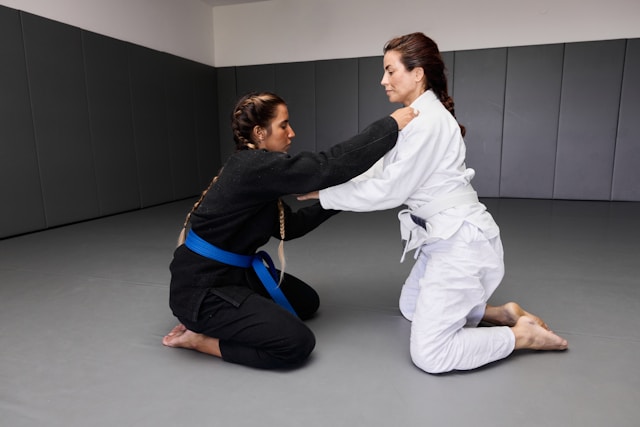
Brazilian Jiu-Jitsu offers a strategic, leverage-based approach to women’s jiu-jitsu self-defense, providing a practical solution when size and strength alone aren’t enough. This martial art transforms fear into empowerment by focusing on joint locks, escapes, and positional control. Beyond physical techniques, the discipline cultivates mental resilience, situational awareness, and community support. This article will explore why women’s jiu-jitsu self-defense matters, break down core techniques, discuss confidence-building, and show how to integrate these skills into everyday life.
Why Women’s Jiu-Jitsu Self-Defense Matters
Understanding why women’s jiu-jitsu self-defense is essential begins with real-world statistics: globally, nearly one in three women experiences physical or sexual violence in her lifetime. Traditional self-defense methods that rely on striking can be less effective against larger attackers. Brazilian Jiu-Jitsu emphasizes technique over brute force, enabling practitioners to use leverage and body mechanics to control or submit an aggressor.
Moreover, women’s martial arts training enhances situational awareness. Students learn to read body language, recognize pre-attack indicators, and maintain safe distances. This proactive approach often defuses potential threats before physical confrontation occurs. In addition, regular practice reduces stress and improves decision-making under pressure, as trainees face controlled challenges on the mat. By mastering physical and mental aspects, women gain a comprehensive toolkit for personal safety.
Core Techniques
Effective women’s jiu-jitsu self-defense begins with fundamental movements designed for real-life scenarios. First, practitioners learn proper posture and base to resist takedowns. Instructors teach break-falls so that students can safely absorb impact and recover quickly when thrown. Next, trainees drill grip control—wrist grabs, collar ties, and underhooks—allowing them to manipulate an attacker’s balance.
Ground defense is a cornerstone of women’s martial arts, since many assaults end on the mat. The guard position lets a smaller defender control an opponent from her back, preventing strikes and creating escape opportunities. Escapes from side control and mount are practiced until they become instinctive reactions. Submissions like the armbar and rear-naked choke serve as decisive measures to incapacitate a violent aggressor, buying critical time to seek help. These core techniques become reliable reflexes under stress through scenario-based sparring with resisting partners.
Building Confidence Through Women’s Jiu-Jitsu Self-Defense
Beyond mastering moves, women’s jiu-jitsu self-defense fosters a profound boost in confidence. Walking into a BJJ academy for the first time can feel intimidating. However, as students earn stripes and progress through belts, they see tangible proof of growth. Successfully executing a sweep or escaping a pin provides a clear milestone that reinforces self-trust.
The communal environment also amplifies confidence. Training partners and instructors create a culture of respect and encouragement. Beginners receive hands-on guidance, making asking questions and refining techniques easier. This supportive atmosphere teaches women to trust their instincts and abilities. Additionally, regular physical activity releases endorphins, reducing anxiety and improving mood. As confidence on the mat grows, practitioners often notice enhanced communication skills, assertiveness at work, and stronger personal boundaries in daily life.
Integrating Women’s Jiu-Jitsu Self-Defense into Daily Life
To reap the full benefits of women’s self-defense, integrate learned skills into everyday routines. Start with simple awareness drills: mentally note exits when entering public spaces, practice maintaining safe distances, and trust intuitive warnings about uncomfortable situations. Visualizing key Jiu-Jitsu escapes—like wrist releases or guard sweeps—helps reinforce neural pathways for quicker physical execution if needed.
At home, dedicate brief intervals for solo drills. Shadow grappling against an imagined attacker refines movement patterns without a partner. Combine these with bodyweight exercises—planks, squats, and hip bridges—to build endurance and core strength essential for holding positions or escaping pins. Role-play scenarios with friends or family can simulate verbal intimidation and teach de-escalation tactics alongside physical responses.
In commuting scenarios, apply situational awareness: walk confidently with your shoulders back, avoid headphones in both ears, and scan surroundings periodically. If grabbed, recall practiced grips and escapes. Consistent mental and physical rehearsal transforms women’s jiu-jitsu self-defense from abstract knowledge into reflexive action, ensuring preparedness in unexpected encounters.
Real-Life Applications and Next Steps
Countless women have leveraged women’s jiu-jitsu self-defense to transform their lives. Consider a graduate student who felt empowered to walk home alone at night after months of training, confidently scanning her environment and prepared to apply escapes if necessary. Or a professional recovering from injury who adapted low-impact BJJ drills to rebuild strength while learning joint-control techniques—skills she later used to defuse a threatening encounter on public transit.
If you’re ready to harness the power of women’s martial arts, take these steps today: research reputable BJJ academies in your area, attend a beginner’s seminar or trial class, and commit to regular training. Invest in comfortable gi or no-gi attire, and seek instructors who emphasize real-world application and supportive learning. As you progress, share insights with friends and family, and consider organizing a small workshop to spread awareness and build community resilience.
By mastering women’s jiu-jitsu self-defense, you gain more than physical techniques—you develop mental fortitude, community support, and a proactive mindset that carries off the mat. Embrace this journey to protect yourself, inspire others, and turn vulnerability into confidence. Your path to true empowerment begins with the first step onto the mat.